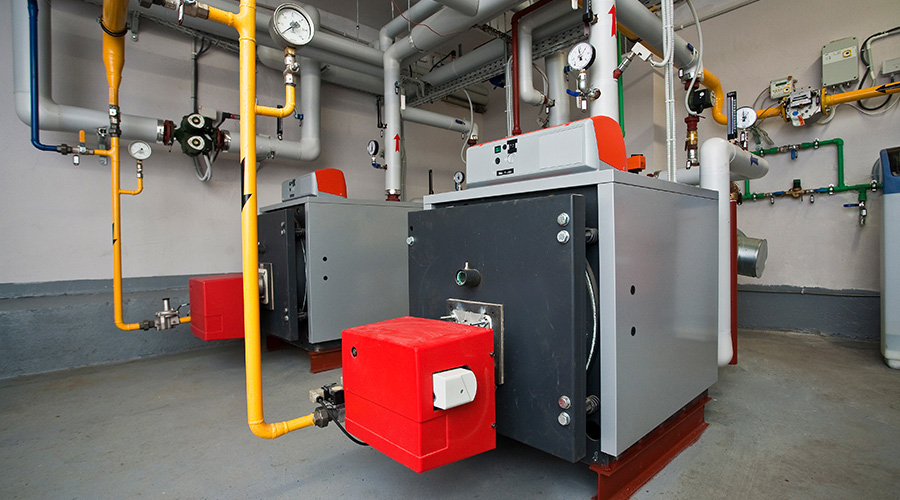Chiller Technology That Saves
Enhanced efficiency, advanced purge systems, and multiple-chiller
operations give managers new opportunities to curtail energy use
Electric chillers represent the single largest electrical load in most buildings, accounting for 35-50 percent of a building’s annual electricity use. For this reason, maintenance and engineering managers who look closely at their building’s chiller system can identify ways to reduce operating and energy costs.
Fortunately, recent developments in chiller technology have given managers tools that can help them achieve higher chiller operating efficiencies. Some technologies are available only with new chillers, while others can be added to most existing applications.
High-efficiency Chillers
The most dramatic improvement in operating efficiency can be achieved by replacing an older chiller with a new, high-efficiency chiller. Centrifugal chillers that are 15-20 years old had a peak efficiency of 0.75-0.85 kw/ton when new, while those that are 10-15 years old had a peak efficiency of 0.60-0.70 kw/ton when new.
But even with a comprehensive chemical water-treatment program and regular tube cleaning, those efficiencies have declined, resulting in peak efficiencies of 0.80-1 kw/ton or lower.
New-generation centrifugal chillers offer peak efficiencies of 0.50 kw/ton or higher. When coupled with variable-frequency drive, they can deliver higher efficiency over a range of cooling loads. High-efficiency chillers can reduce annual cooling energy requirements by 30-50 percent in most applications.
Software
The development of chiller management and maintenance software is one of the most significant developments in improving chiller efficiency. These programs allow continuous monitoring of chiller operation, providing operators and managers with information on cooling rates, kw/ton efficiency calculations for different cooling loads, operating costs, water-flow rates, and water temperatures.
Operators who use the software can identify developing problems and situations in which a chiller is operating outside of design performance conditions. The software also indicates when temperature and flow sensors have gone out of calibration. In plants that use multiple chillers, the programs can identify chillers that can help meet the current load at the highest operating efficiency.
High-efficiency Purge Systems
Contaminants in a chiller’s refrigerant circuit reduce operating efficiency. Low-pressure systems, such as centrifugal chillers, are more susceptible to contaminants because any leak can introduce air and moisture to the system.
Technicians should regularly monitor purge units’ run times. Any change in operation can be an early warning sign of a developing leak.
To minimize the impact of contaminants, purge systems on chillers separate both air and moisture from the refrigerant. While these systems worked, they were not very efficient and did not remove all of the contaminants. Their use also resulted in lost refrigerant.
New-generation, higher-efficiency purge systems — available on new chillers or retrofitted to existing chillers— are both very efficient and very effective. They separate most of the air and moisture from the refrigerant, and they do so without allowing refrigerant to escape. The result is a refrigerant that is practically free of efficiency-robbing contaminants.
Oil-less Centrifugal Chillers
One problem that cuts into the operating efficiency of many centrifugal chillers is oil contamination of the refrigerant circuit. The drive systems of most centrifugal chillers use a series of gears, which requires lubrication. In normal operation, only a small amount of this oil ever ends up in the refrigerant circuit.
Eventually, this oil collects in the evaporator, decreasing system capacity and efficiency. Special purge units that remove the oil from the refrigerant can help, but they cannot remove it all, nor can they clean the interior of the tubes.
Advanced designs enable new centrifugal chillers to operate without using gears — a direct-drive system — allowing the units to operate without oil. This advance eliminates the risk of oil contamination and the resulting loss of operating efficiency. Centrifugal chillers that do not require oil also offer the promise of reduced maintenance requirements and higher reliability, due to simpler design and lower part count.
Multiple-chiller Installations
One common mistake from an operations standpoint is designing a central chilled-water plant around one chiller. While using one chiller reduces initial costs and saves space, it can cause problems for managers.
A single-chiller operation gives managers no backup. The failure of one chiller means the facility must operate without air conditioning. If technicians have to order replacement parts or if the chiller needs to undergo a major overhaul, that outage can last a long time.
A single-chiller operation also can result in lower operating efficiency. Chillers must be sized to meet a facility’s peak cooling load, even though that peak load might occur for only a few hours annually.
Unfortunately, operating efficiency falls off very quickly as the load decreases, causing the chiller to operate at reduced efficiency for more than 95 percent of the cooling season. While variable-frequency drives offer improved efficiency over a fairly wide range of operating loads, they cannot fully compensate for losses in chiller efficiency at lower loads.
An alternative approach is to use multiple chillers with different capacities. A facility would need the chillers’ combined capacities only at its peak cooling load. As the load decreases from peak, managers could select the chiller that most closely matches the cooling load, thus improving the operating efficiency of the cooling plant over the entire cooling season. A multiple-chiller installation also would provide greater backup should one chiller fail.
Alternative-fuel Chillers
In large applications, electric-drive, centrifugal chillers have long been the choice for building air conditioning. But while they remain a good choice for many applications, facilities with a large, central chilled-water plant with multiple chillers might benefit from alternative-fuel chillers.
These chillers might not offer improved operating efficiency, but they can reduce operating costs because of changes brought about by deregulation. Deregulation has allowed real-time pricing for electricity, so engineering and maintenance managers have a strong incentive to reduce their peak electricity loads. Cooling loads often closely track a facility’s peak electrical load, so any reduction in chiller electricity use during peak periods can generate significant savings.
New-technology chillers — including direct-fired absorption and natural-gas-driven centrifugal chillers — allow managers to use an alternative fuel to produce chilled water when electricity rates are high. Plants using both conventional and alternative-fuel chillers allow managers to choose the most cost-effective chiller, based on the cost of the energy source at a particular time.
Taken together, the recent advances in chiller design means significant savings for institutional and commercial facilities. Managers that take advantage of new technologies and design features can expect these systems to use only 50-60 percent of the energy required by systems installed as recently as 10-15 years ago.
James Piper is a national consultant with more than 25 years of experience in facilities maintenance and management issues.
Efficiency Strategy: Refrigerant Management
Proper refrigerant management is one of the most effective tools for maintaining or improving a chiller’s operating efficiency. Unfortunately, most managers think of refrigerant management in terms of compliance with regulations, refrigerant inventories, and chiller-refrigerant conversions.
In fact, refrigerant management is a proven strategy for ensuring that chillers operate at the highest possible efficiency. During chiller operation, small leaks develop in sealed refrigerant systems. As the system loses refrigerant — often gradually and unnoticed — the unit’s operating efficiency drops.
When technicians notice the loss, they add the required amount and enter it in the chiller log. But as long as the loss is smaller than the action level required by environmental regulations, it requires no additional action, even though the leak continues.
To maximize chiller efficiency, technicians need to monitor the addition of refrigerant to any chiller. And managers need to review their operation regularly to determine trends or changes that might indicate performance-inhibiting refrigerant leaks.
— James Piper
|
Related Topics:











